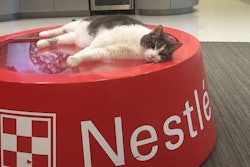
Dog and cat treats with health and functional claims are increasingly popular: 70 percent of US consumers say treats with functional benefits play an important role in their pets’ health, and 71 percent look for treats that address health concerns or offer extra nutrition, according to a June/July 2017 survey by Packaged Facts.
Yet it also showed that pet owners use treats to bond with and pamper their pets; indulgent treats are the largest category among dog treats, at 35 percent (www.PetfoodIndustry.com/articles/6646). And new research from Mintel reveals that 75 percent of US pet owners say treats are a way to show their pets love.
In both respects, pet treats mimic trends in human snacks. In a May 2017 study from Mintel, the top reason (at 50 percent) American consumers gave for snacking is to treat themselves. But while 28 percent ranked taste over health, 32 percent claimed that most snacks they eat are healthy. Research from GlobalData shows consumers worldwide are snacking more, with 72 percent saying so. Interestingly, it’s higher among pet owners, at 82 percent.
Pet treat sales growing globally
Sales of dog treats worldwide reached US$7 billion in 2015, according to Euromonitor, building on 26 percent growth since 2010. Euromonitor data from this year showed dog treat sales in Western Europe have increased about 5 percent annually since 2012, up to about US$2.25 billion.
In the US, Packaged Facts projects pet treat sales to reach US$6.4 billion by the end of 2017, thanks to growth outpacing the overall US pet food market. Mintel’s new study put that growth rate at 29 percent from 2012 to 2017. Popular categories included functional claims such as dental and oral health, skin and coat, and joint health.
But we can’t overlook the indulgence factor: Seasonal treats, such as for Christmas and Halloween, soared over 200 percent in US pet specialty sales from 2014 to 2015, according to GfK. It seems that with treats, dogs and cats can have their (healthy) cake and eat it, too.















